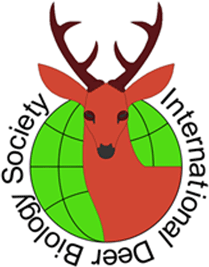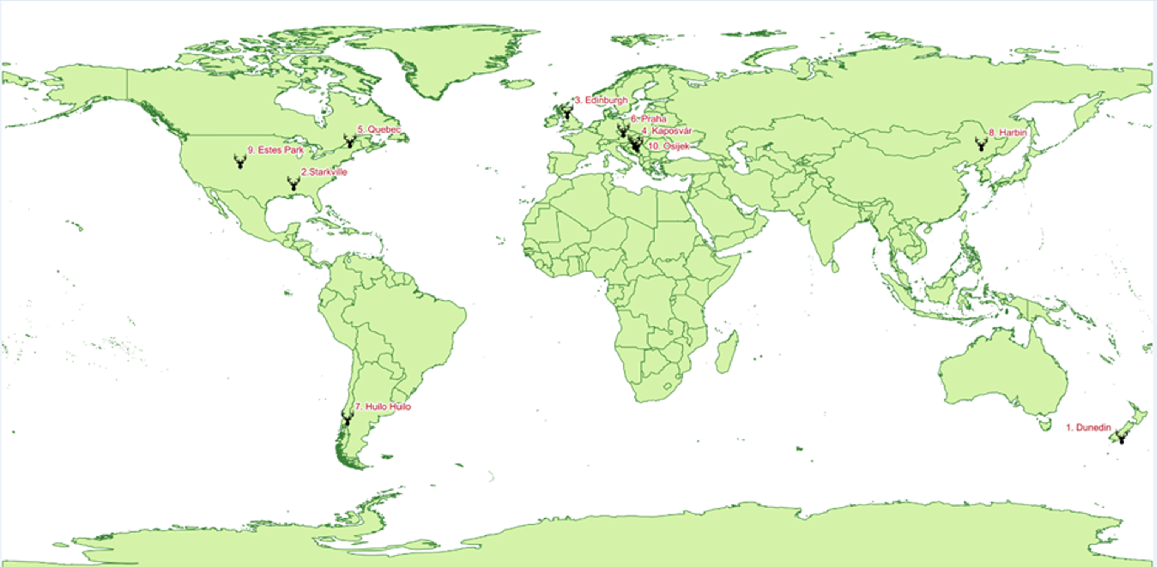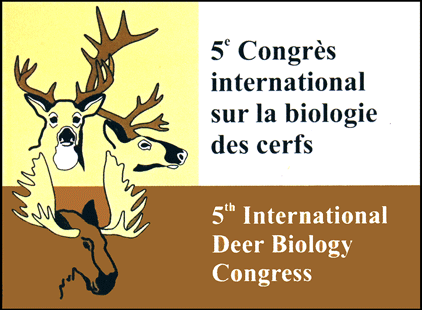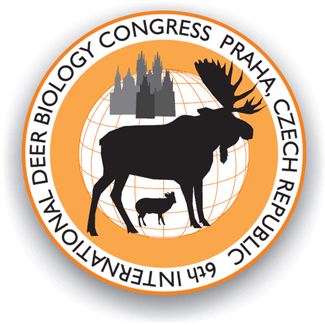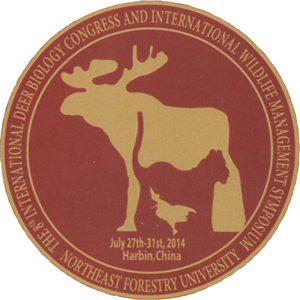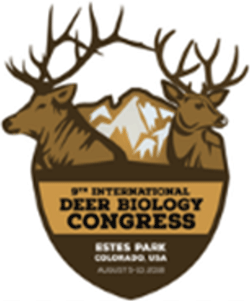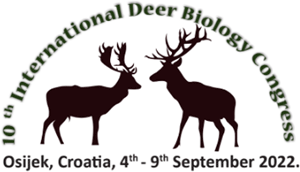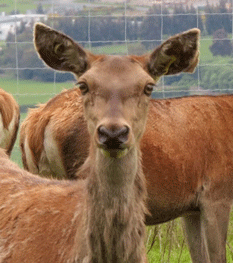A brief history of the International Deer Biology Congress
László I. Sugár A * , Jo Anne M. Smith-Flueck B C and Gordon McL. Dryden
B C and Gordon McL. Dryden  D E
D E
A
B
C
D
E
Animal Production Science 63(16) 1564-1572 https://doi.org/10.1071/AN23311
Submitted: 17 September 2023 Accepted: 2 October 2023 Published: 30 October 2023
Abstract
The quadrennial International Deer Biology Congresses reflect the world-wide interest in the ecology, biology, and conservation biology of deer and use of cervine products. The origins and development of the International Deer Biology Congress are described in this article.
Keywords: antler science, cervine products, cervids, deer behaviour, deer conservation, deer distribution, deer ecology, deer management, deer nutrition, deer physiology, deer reproduction, ethology, evolution, feeding behaviour, genetics, mineral nutrition, phylogeny, Traditional Asian medicine, venison products.
Introduction
Deer are native in Europe, North and South America, throughout Asia as far south as Indonesia, and in Papua New Guinea. They have been introduced to New Zealand, New Caledonia, Australia and some Pacific islands where they have become naturalised.
In many regions deer are considered to be cultural treasures, they provide recreation as a hunting resource, and they are sources of farmed products for food and medicine. Interest in deer biology and ecology ranges from designing efficient farming systems, to maintaining the sustainability of threatened species, and to coping with over-abundant deer populations. This variety of features has, over the past 40 years, generated a series of conferences on deer farming, antler science and technology, and other aspects of the management and biology of deer. Many of these conferences are quite specialised, but the International Deer Biology Congress (IDBC) series is unique in that the topics considered at these congresses embrace the whole range of physiology, behaviour, ecology, management, reproduction and breeding, health, nutrition, etc. that are related to the biology and management of deer.
The origins of the IDBC – scientific interest in the biology of deer in Europe, the United States and New Zealand
As interest in the management and conservation of deer developed in the mid-20th century, there was increasing interest in recording and sharing this knowledge, and this led to the now very successful series of IDBC. This development came from different places and from quite disparate contexts, but especially from the need to understand the biology of wild European and North American deer, and from the research needed to underpin the developing New Zealand deer farming industry.
Some of the early impetus originated in Europe. László Sugár recalls that ‘As a child, I spent every summer in a village at my grandparents enjoying the great variety of domestic animals and wildlife including roe deer. I first decided to become a vet at about the age of 10. At university, I pursued studies concerning wildlife. Then in 1972, I got a job at the new Game Biology Station nearby to Budapest. As a vet, my main interest was primarily on parasites. Nevertheless, my favourite animals were deer from the beginning: the native red deer and roe deer as well as fallow deer, which were introduced to Hungary around the 15th century. I started to collect as much information as possible, especially on reproduction and general health status to understand the impact of parasites in deer species.’
László recounts, ‘In 1982 I gained employment at the Agricultural College, Kaposvár, when I began to monitor and study red deer of Somogy county. In connection with the research activity I tried to take every opportunity to learn and share ideas and experiences, especially at conferences like the Congress of the International Union of Game Biologists (IUGB). I interacted with many scientists including just a few names: Anthony and George Bubenik (Canada), Norma Chapman (Great Britain), Hermann Ellenberg and Rudolf. R. Hofmann (Germany).’
Then, on a midsummer day in 1983 a New Zealand deer farmer, Bernard Pinney, visited Kaposvár, the centre of the Somogy Forestry Company. The aim was to discuss the possibilities of capturing feral red deer (Cervus elaphus) for export to New Zealand. Somogy county red deer were chosen after evaluating the antler characteristics observed at international trophy shows; the antlers of Somogy stags have measurements of the length and diameter of the beam like those in other good-quality populations in Hungary/Europe, but, in addition, show just three or four (i.e. not too many) long and thick branches in the coronet. (Note that the optimal time for cutting velvet antler for the traditional Chinese market is just before the branching of the coronet, which is about 60 days after shedding the old antler). After discussions, the decision was made to capture live deer of both sexes, which would undergo local quarantine and then be transported to New Zealand via England. After two winters of successful captures, about 120 animals were transported to their new home.
Deer farming in China and the developing industry in New Zealand concentrated on the production of antler products and, consequently, on antler quality. This is illustrated by the fact that in the early 1990s, two stags born in Hungary were sold at auctions in New Zealand for NZ$100 000 and NZ$120 000.
The economic importance of deer antler products increased scientific attention, and an international conference Antler Development in Cervidae was organised in 1982 in Kingsville, Texas, by Robert Brown. This conference gave impetus to the succeeding conferences on antler science and product technology, and may also have stimulated the organisation of the first international deer biology conference, held in 1983.
Deer Biology Conference, New Zealand: the first international deer biology conference
The now well-established sequence of deer biology conferences (now known as the IDBC) started with a conference held in Dunedin, New Zealand, in February, 1983. It was organised by Ken Drew and Peter Fennessy, and reflected the knowledge gained throughout the first decade of New Zealand deer farming. The conference papers (Drew and Fennessy 1985) were published as Biology of Deer Production. There were no plenary speakers identified as such at this conference but a concluding address ‘Deer: yesterday, today and tomorrow’ was given by Professor R. V. Short.
László Sugár recalls that ‘In 1995 one of the New Zealand visitors gave me a brand new copy of the Biology of Deer Production. It served as a bible for our deer research group for many years.’
International Union of Game Biologists Congress in Krakow, Poland 1987
László Sugár notes that ‘In 1986 while perusing the 18th Congress of the International Union of Game Biologists (IUGB), I came upon the ‘Deer Farming’ session held by Peter Fennessy (AgResearch, Invermay, New Zealand). This gave me an idea. Why not invite him to visit Kaposvár to discuss our plan to hold a second congress on the ‘Biology of Deer’ in the future. I shared the idea with our university leader, Professor Peter Horn, who agreed. Soon we sent a letter to Peter Fennessy. He replied that he was sorry he couldn’t make it but Colin Mackintosh from Invermay, New Zealand, would come in his place. Colin and I then met at the IUGB Congress in Krakow in 1987 and spent several days together at the post-congress tour to Popielno to see Professor Z. Jacewski’s famous deer research unit (antler physiology). During the 3 day tour, I also spent a lot of time with Whitley Otway (New Zealand), a physician educated in traditional Korean medicine, and one of the founders of the New Zealand Deer Farmers Association. Later, in 1988, I would spend an unforgettable time visiting him: seeing the wonderful Mesopotamian fallow deer and watching the intrauterine fertilisation of red deer hinds with Père David’s deer semen for the successful hybridisation. Some days later Colin arrived in Hungary. While visiting our campus and deer farm, he accepted that our university would be a good host of the deer congress somewhat later.’
Letter from Professor Robert Brown
But the envisaged program would not be fulfilled immediately. Soon a letter arrived from Mississippi. Professor Robert Brown wrote that he had received a sponsorship offer: if they organised an international congress on the biology of deer, they could get US$30 000. He was interested in holding the second congress in Starkville (Mississippi, USA) instead of Kaposvár, if it suited everyone.
The Kaposvár deer research team accepted the proposal, while stressing their intention to organise the following conference in Kaposvár.
The second and third conferences
The second in the series of the history of IDBC was The International Symposium on the Biology of Deer, which was held 28 May to 1 June 1990, at Starkville, Mississippi, USA. The Chairman of the Local Organising Committee was Robert D. Brown. The proceedings were published as The Biology of Deer (Brown 1992). The organisers of the 2nd Congress introduced the concept of plenary talks, i.e. presentations on currently important topics by scientists who were recognised as expert in their field. These presenters, and those who gave plenaries at the succeeding Congresses, are listed in the Appendix.
At the end of the Starkville conference, both Kaposvár and Edinburgh offered to host the third conference, and the latter offer was accepted.
The third in the IDBC series was titled the 3rd International Conference on the Biology of Deer, and was held 28 August to 2 September, 1994, in Edinburgh, Scotland. The Chairman of the Local Organising Committee was John Milne. John also edited the proceedings, Recent Developments in Deer Biology (Milne 1994).
It was in Edinburgh that the Kaposvár group was finally given the task to organise the next conference in Hungary.
Formation of the Scientific Steering Committee and a new name for the Congress
After the 3rd Conference, a Scientific Steering Committee was appointed of foremost deer biologists, with Ken Drew as the first chairperson. The tasks of this committee were to choose the location of each congress, to develop guidelines for the conference structure, to invite plenary speakers, and to liaise with a local organising committee.
The name of this sequence of conferences was reconsidered. László Sugár put forward the idea to change the name of the next conference to the 4th International Deer Biology Congress, and this was accepted by the Scientific Steering Committee.
The fourth International Deer Biology Congress
The 4th International Deer Biology Congress was held 30 June to 4 July 1998 at Kaposvár, Hungary (Fig. 1). László Sugár chaired the Local Organising Committee. For the preparation of the congress, it was fortunate that email had become the main tool of communication by then, making the organisers’ task much easier and effective. Emails were exchanged frequently, sometimes daily, between Ken Drew (the chairperson of the Scientific Steering Committee) and László, to discuss the session topics, plenary speakers, and the most suitable schedule. By coincidence, the Second World Deer Farming Congress was being arranged in Limerick, Ireland, that same summer. The two meetings were therefore placed back to back. Many delegates attended the Deer Farming Congress in Ireland from 24 to 28 June and then moved onto the Deer Biology Congress in Hungary immediately afterwards.
At the 4th Congress, the Tony Bubenik Memorial Award for young scientists (younger than 35 years) was first presented. This award, established by his son George A. Bubenik and family and friends, was always presented by George himself. The criteria for the selection were as follows: the originality of the research idea and the innovation of the technique used; the excellence in evaluating the data; the clarity of presentation; and the knowledgeable discussion of results with the public. The award was presented from the 4th to the 6th congresses.
The plenary papers from the 4th Congress were published in Volumes 46 and 47 of Acta Veterinaria Hungarica, and these and other submitted and reviewed contributions were published as Advances in Deer Biology (Zomborsky 1999).
The logo of the International Deer Biology Society, designed by László Sugár, with graphic work by Zsigmond Sugár, was initially used as the logo for the 4th Congress.
The fifth International Deer Biology Congress
The 5th International Deer Biology Congress was held 25–30 August 2002 in Quebec City, Canada. The chairman of the Local Organising Committee for the 5th IDBC was Michel Crȇte and the chair of the Scientific Steering Committee was Antoine J Sempéré. Selected papers presented at the Quebec Congress were published in Volume 10 of the journal Écoscience, and other submitted full papers and abstracts were published in the Conference Proceedings (Crȇte 2003) and the Scientific Program and Abstracts.
At this congress, Jo Anne Smith-Flueck was elected to chair the Scientific Steering Committee, to take office after the 5th Congress.
The sixth Congress and formation of the Deer Biology Society
The 6th International Deer Biology Congress was held in Prague, Czech Republic, on 7–11 August 2006. Ludĕk Bartoš chaired the Local Organising Committee, and Jo Anne Smith-Flueck chaired the Scientific Steering Committee. Abstracts of the presentations were published as Advances in Deer Biology (Bartoš et al. 2006). A list of oral presentations and posters is available at http://idbc.agrobiology.eu/#program.
Some avertible inconveniences prior to the 5th Congress inspired the development of a set of statutes to guide the organisation of the congresses and to define the roles of the Scientific Steering Committee and the Local Organising Committee. Shortly after the 6th IDBC, the Scientific Steering Committee began working on the statutes to form the basis of the Society and to assure continuence of these international congresses.
Another important outcome of the 6th Congress was the development of the IUCN Huemul Working Group as a subgroup of the Deer Specialist Group. Twenty-four participants representing 12 countries attended a congress workshop (http://idbc.agrobiology.eu/huemul.htm) to find solutions to reverse the decline of the South American huemul, the most endangered deer of the Americas. Robin Gill was selected as initial coordinator to form the Huemul Group, which was later renamed the Huemul Task Force.
Adoption of statutes and the seventh Congress
A mandate from the delegates of the 6th IDBC inspired the founding of the International Deer Biology Society by the Scientific Steering Committee in 2006. The statutes for the Society, finalised after several years of work, were adopted unanimously by the Scientific Steering Committee in March 2009. They state that the principal objectives of the Society are to ensure the continuation of the International Deer Biology Congress on a regular basis and to manage the Congress, acting through the Scientific Steering Committee. Distinguishing the unique roles of the Scientific Steering Committee and the Organising Committee, as defined in the Statutes, has been fundamental in running each congress smoothly and successfully ever since. The logo used for the 4th Congress further served as a template for the official logo of the International Deer Biology Society.
The following year, the 7th International Deer Biology Congress was held. It was notable for moving the venues to regions other than Europe and North America for the first time. It was to have been held in Pucon, Chile, but this not being possible, the venue was moved at short notice and the Congress was held 1–6 August 2010 at the Huilo Huilo Biological Reserve, Neltume, Chile. The chair of the Local Organising Committee was Werner Flueck, with event co-chairs being Ivonne Reifschneider, Alexandra Petermann and Jo Anne Smith-Flueck (who also chaired the Scientific Steering Committee).
This Congress was attended by 260 scientists from 23 countries, and it was an unprecedented opportunity for South American researchers to publicise their work. It was notable for the number of papers submitted, and for the emphasis on the local endangered huemul deer. International Huemul Day, now celebrated every year on the 5 August, originated in 2010 as a request by the 7th IDBC organisers to the IUCN RedList administrators to include huemul in their ‘Species of the Day’ program. The starting date for that tradition fell intentionally on 5 August to be celebrated during the Congress. Abstracts of the presentations were collected in Advances and Challenges in Deer Biology (Flueck et al. 2010).
It was first noticed in 2002 that presentations to the IDBC were not getting sufficient exposure, and so arrangements for publishing the proceedings were made to give greater access, and to allow for more effective citation. To achieve this, the plenary papers and other contributed full papers were published as special issues of Animal Production Science. In fact, so many papers from the 7th IDBC were submitted that the journal published two special issues (Flueck et al. 2011; Dryden 2012).
The eighth Congress
The 8th International Deer Biology Congress was held in Asia for the first time. China, as the site for the 8th Congress, reflected its position as a likely cradle of deer. It is in China where we find extant antlerless forms of deer including Chinese water deer, or others such as muntjac and Père David’s deer (milu). Although palealogical evidence is scanty, it is assumed that deer populations moved eastward across the Bering land bridge to Alaska, other parts of North America, and slowly expanded southward across North and then South America to Tierra del Fuego (Harrington 1985; Geist 1998). On the way, they were followed by their predators and parasites leading to further differentiation due to co-adaptation and co-evolution, resulting in the colourful diversity we see today.
The venue of the 8th Congress, held 27–31 July 2014, was in Harbin, China, at the Department of Wildlife Conservation and Nature Reserve Management, Northeast Forest University. The chair of the Local Organising Committee was Minghai Zhang, with event co-chairs Jianzhang Ma and Chuanping Yang (Chancellor of Northeast Forest University). Jo Anne Smith-Flueck chaired the Scientific Standing Committee. The Congress was run in conjunction with the International Wildlife Management Symposium (chaired by Jianzhang Ma [1937–2022], recognised as the father of Chinese wildlife conservation and management) and together they attracted over 300 delegates. It had been immediately preceded by the First International and the Second National Symposium on Antler Science and Technology, which was organised at Dalian, China, by Yukui Zhang and Chunyi Li. Some delegates to the 8th International Deer Biology Congress attended both meetings.
The Congress abstracts were published in Proceedings (Ma et al. 2014). Papers from both meetings were published in an Animal Production Science special issue (Dryden 2016).
Ninth and tenth Congresses
The 9th International Deer Biology Congress was held 5–10 August 2018 at Estes Park, Colorado, USA, bordering with the Rocky Mountain National Park. Chair of the Local Organising Committee was David Hewitt, with event co-chairs Randy DeYoung, Jim Heffelfinger, and Kurt Vercauteren. Jo Anne Smith-Flueck chaired the Scientific Steering Committee. Full papers from the Congress, and from the 4th Antler Science and Product Technology Conference, again chaired by Chunyi Li, were published as a special issue of Animal Production Science (Dryden and Li 2020). Summaries of the oral and poster presentations to the Congress are available at SCHED (2023).
Osijek, Croatia, was the venue for the 10th International Deer Biology Congress, held 5–9 September 2022. The chairman of the Local Organising Committee was Dean Konjević, and Jo Anne Smith-Flueck chaired the Scientific Steering Committee.
Regretfully, the eminent deer biologist Dr George Bubenik died in 2018. To acknowledge his outstanding achievements, the Congress now presents the George A. Bubenik Memorial Award to a young scientist (less than 35 years of age) for the best submitted presentation at each congress. At the 10th Congress, the Scientific Steering Committee also initiated an award for the best poster.
A notable feature of the 10th Congress was that women were first authors on 34.5% of all presentations. This compares with 19.5% of the presentations made at the 4th Congress in Kaposvár, Hungary, in 1998. This is a telling sign that women have become increasingly involved in deer biology.
Again, Congress abstracts were published by Konjević et al. (2022). Full papers were published in a special issue of Animal Production Science (Dryden and Smith-Flueck 2023). This time, as well as the plenary papers, several other presenters’ abstracts were selected by the Scientific Steering Committee and the authors were invited to contribute full papers. As well, all presenters were invited to contribute short communications for publication in the special issue.
And we will return to where we started: New Zealand for the 11th meeting
The international interest and research in deer biology is illustrated by the world-wide distribution of congress locations (Fig. 1). The 11th Congress will bring us full circle by returning to where we first began. New Zealand has been selected as the venue for the 11th meeting, to be hosted in Dunedin by AgResearch and Deer Industry New Zealand.
We all have to help preserve this Deer World, and the International Deer Biology Congresses have made a substantial contribution.
Data availability
Data sharing is not applicable as no new data were generated or analysed in preparing this article.
Conflicts of interest
Gordon Dryden is an Associate Editor of Animal Production Science. To mitigate this potential conflict of interest they were blinded from the review process. The other authors declare that they have no conflicts of interest.
Acknowledgements
We thank Nicolas Tyler for editing an earlier version of this paper and Wayne Bryden for his interest and helpful comments. The 7th to 10th proceedings were published as special issues of Animal Production Science and are available at https://www.publish.csiro.au/an/content/specialissues.
References
Brown RD (Ed.) (1992) ‘The biology of deer.’ (Springer Verlag: New York, NY, USA). Available at https://link.springer.com/book/10.1007/978-1-4612-2782-3#toc [verified 19 September 2023]
Dryden GMcL (Ed.) (2012) Deer physiology, reproduction and management. Animal Production Science52(8), 681–785. Available at https://www.publish.csiro.au/AN/issue/5832
Dryden GMcL (Ed.) (2016) 8th International Deer Biology Congress. Animal Production Science56(6), 1–74. Available at https://www.publish.csiro.au/AN/issue/7681
Dryden GMcL, Li C (Eds) (2020) 9th International Deer Biology Congress, Estes Park, Colorado, USA, 2018, and 4th International Symposium on Antler Science and Product Technology, Changchun City, Jilin Province, China, 2018. Animal Production Science60(10), 1227–1367. Available at https://www.publish.csiro.au/AN/issue/10015
Flueck W, Smith-Flueck J, Charrier A (Eds) (2010) Advances and challenges in deer biology. Available at https://deerlab.org/Publ/pdfs/106.pdf [verified 16 September 2023]
SCHED (2023) 9th international deer biology congress. Available at https://idbc2018.sched.com/type/ [verified 20 September 2023]
Appendix.Lists of plenary speakers at the second and subsequent Congresses
Starkville, Mississippi, USA 1990
Albon SD, Clutton-Brock TH and Langvatn R. Cohort variation in reproduction and survival: implications for population demography
Dratch PA and Pemberton JM. Application of biochemical genetics to deer management: what the gels tell
Haig JC. Requirements for managing farmed deer
Klein DR. The status of deer in a changing world environment
Lincoln GA. Biology of seasonal breeding in deer
Loudon ASI and Brinklow BR. Reproduction in deer: adaptations for life in seasonal environments
Reid HW. The biology of a fatal herpesvirus infection of deer (malignant catarrhal fever)
Suttie JM and Fennessy PF. Recent advances in the physiological control of velvet antler growth
White RG. Nutrition in relation to season, lactation, and growth of north temperate deer
Edinburgh, Scotland 1994
Adam CL Factors influencing the timing of puberty in deer
Albon SD, Coulson TN and Clutton-Brock TH. Demographic constraints in red deer (Cervus elaphus): can the past predict the future?
Asher, GW, Fisher SL, Montfort SL and Mylrea GK. Endocrine control of reproduction in Cervids: the enigma of temperate vs tropical species
Cronin MA. Molecular evolutionary genetics of cervids
Festa-Bianchet M and Apollonio M. New prospectives on the social behaviour of wild Cervids
Goddard PJ and Matthews LR. Stress and animal welfare
Griffin JFT, Mackintosh CG and Buchan GS. Diagnosis and prevention of mycobacterial disease
Hanley TA. Blacktailed deer (Odocoileus hemionus) and forest management in Alaska: practical lessons from the pursuit of foraging theory
Jacobson HA and Krill JC. The white-tailed deer (Odocoileus virginianus) ‘the most managed and mismanaged species’
Liberg O, Cederlund G and Kjellander P. Population dynamics of roe deer (Caproelus capreolus) in Sweden: a brief review of past and present
Loudoin ASI and Jabbour HN. Seasonal rhythms in the physiology of deer: endogenous clocks and target tissues
Pemberton JM and Slate J. Genetic studies of wild deer populations: a technical revolution
Reid HW. Towards understanding malignant catarrhal fever
Sempéré A, Danilkin AA and Pereladova OB. Distribution, management and status of wild cervids in Europe and the previous USSR territories
Spalinger DE. Foraging behaviour of cervids: constraints, adaptation and optimal foraging
Staines BW. The management of red deer (Cervus elaphus) in the context of other land uses in Scotland
Suttie JM, Li C, Sadighi M, Gunn J and Fleming JS. Physiological control of antler growth
Tate ML, Mathias HC, Hill DF and Fennessy PF. Development and applications of a genetic linkage map of deer
Vigh-Larsen F and Davies MH. Seasonal rhythms – implications for deer farm management
Kaposvár, Hungary 1998
Barry TN, Wilson PR and Semiadi G. Growth, voluntary intake and digestion in farmed temperate and tropical deer
Crête M and Daigle C. Management of indigenous North American deer at the end of the 20th century in relation to large predators and primary production
Goddard PJ. The welfare of deer
Lincoln GA. Photoperiod-melatonin relay in deer
Mackintosh CG. Deer health and disease
Pearse AJ and Drew KR. Ecologically sound management: Aspects of modern sustainable deer farming systems
Perez-Barberia FJ and Gordon IJ. The influence of sexual dimorphism in body size and mouth morphology on diet selection and sexual segregation in cervids
Suttie JM, Li C, Bubenik GA and Rolf HJ. Studies of antler growth: a review of the literature
Tate ML, Anderson RM, McEwan KM, Goosen GJ and Pearse AJ. Genetic analysis of farmed deer hybrids
Quebec, Canada 2002
Asher GW. Advances in deer reproductive biology
Augustine D and de Calesta D. Defining deer overabundance: from individual plants to landscape structure
Boyce MS, Mao JS, Fortin D, Merrill EH, Fryxell J, Turchin P and Turner MG. Scale and heterogeneity of habitat selection by elk in Yellowstone
Cronin MA. The importance of taxonomy in deer management
Decker DJ, Riley SJ, Enck JW, Curtis PD, Lauber TB and Brown TL. Deer populations up, hunter populations down: implications of interdependence of deer and hunter population dynamics on management
Festa-Bianchet M. What does selective hunting really select for?
Gaillard JM, Loison A and Toïgo C. Sources of individual variation and deer population dynamics
Hudson RJ and Jeon B-T. Nutrition of farmed deer: lessons from the wild
Lindzey F. Competition among North American cervids: should managers be concerned?
Messier F.l Recovery of wolves and mountain lions in western North America: a new reality for Cervidae
Parker KL. Advances in the nutritional ecology of cervids at different scales
Pond C. The contribution of wild animal biology to human physiology and medicine
Semiadi G. Conservation status and research trends on Asian deer
Sempéré AJ. Physiological regulation and behavioural function of antlers in cervids
Weber M and Gonzalez S. Conservation status and research trends on Latin American deer
Wiklund E, Drew K and Åhman B. Wild and tender deer meat
Wilson PR and Davies PR. Deer diseases and human health: an internationally significant issue
Prague, Czech Republic 2006
Apollonio M. Fallow deer, lekking and alternative strategies in San Rossore, Italy: insights from a long term study
Bubenik GA. Seasonal versus non-seasonal reproduction in deer: from the arctic to the tropics
Forchhammer MC. Deer responses to global environmental changes
Geist V. Priorities in Cervid conservation: why science, zoogeography and history do matter
Li C and Suttie JM. Recent progress in antler regeneration and stem cell research
McShea WJ. Conservation of tropical deer: what does the future hold?
Woodbury MR and Campbell JR. Emerging disease in wild and captive cervids
Huilo Huilo, Chile 2010
Bartoš L. Relationships between rank related behaviours and antler growth in deer
Dryden GMcL. Nutrition of deer – a quantitative approach
Li C, Yang F and Suttie J. Stem cells, stem cell niche and antler development
Putman R and Flueck WT. Intraspecific variation in biology and ecology of deer: magnitude and causation
Saltz D. Reintroducing the Persian fallow deer – a chronology of ups and downs
Warren RJ. Deer overabundance revisited: recent advances, challenges and opportunities
Harbin, China 2014
Hoover EA. Chronic wasting disease: Its detection, transmission, pathogenesis and risk factors for cervid and non-cervid species
Koh HS. Genetic divergence in three species of deer (the Chinese water deer Hydropotes inermis, the Siberian roe deer Capreolus pygargus, and the sika deer Cervus nippon) from Korea and other regions in Asia, with conservation of the three species in Korea
Huo Y. Clinical applications of deer antler products on traditional Chinese medicine and modern medicine
Jiang Z, Kaji K and Ping X. The tale of two deer: management of milu and sika deer in anthropogenic landscape of East Asia
Li C. Recent progress on antler stem cells and regeneration
McCullough D. Deer irruptions and overpopulation studies in the US and Japan
Estes Park, USA 2018
Asher GW. Impacts of nutrition on reproduction in female red deer: phenotypic flexibility within a photoperiod-mediated seasonal cycle
Cagnacci F, Peters W and Hebblewhite M. Movement, migration and ecological plasticity in deer species: facts and consequences in a changing European landscape
Comizzoli P. Integrating fertility preservation and cryo-banking into the conservation of rare and endangered deer species
Demarais S. Soil, land use, and genetic potential – connecting the dots of deer ecology and management
Li C. Deer antlers: traditional Chinese medicine use and recent pharmaceuticals
Merkle JA. Ecology and conservation of ungulate migration: lessons from Wyoming
Miller M. The ‘first’ five decades of chronic wasting disease: lessons learned
Tyler NJC, Gregorini P, Parker KL and Hazlerigg DG. Animal responses to environmental variation: physiological mechanisms in ecological models of performance in deer (Cervidae)
Osijek, Croatia 2022
Apollonio M and Chirichella R. Deer and climate change: impacts and perspectives
Ceacero F, Ny V, Kotrba R, Bartoš L, Čupić S, Bureš D, Turek J, Komárková M and Needham T. Combined effects of supplementation of amino acids and immunocastration in first antler growth of farmed fallow deer (Dama dama)
Kierdorf U, Ludolphy C and Kierdorf H. Antlers as bioindicators of environmental pollution: principles, achievements, and future research directions
Konjević D. Fascioloides magna – a development of host-parasite interactions in Europe
Landete-Castillejo T, Rossetti A, Garcia AJ, de Cabo C, Festuccia C, Luna S and Chonco L. From a general anti-cancer treatment to antioxidant or deer osteoporosis: the consequences of antler as the fastest growing tissue
Latch E and Heffelfinger JR. Genetics informs meaningful intraspecific taxonomy: the black-tailed and mule deer complex
Nellemann C and Tyler N. Global threats to deer conservation in a changing world


